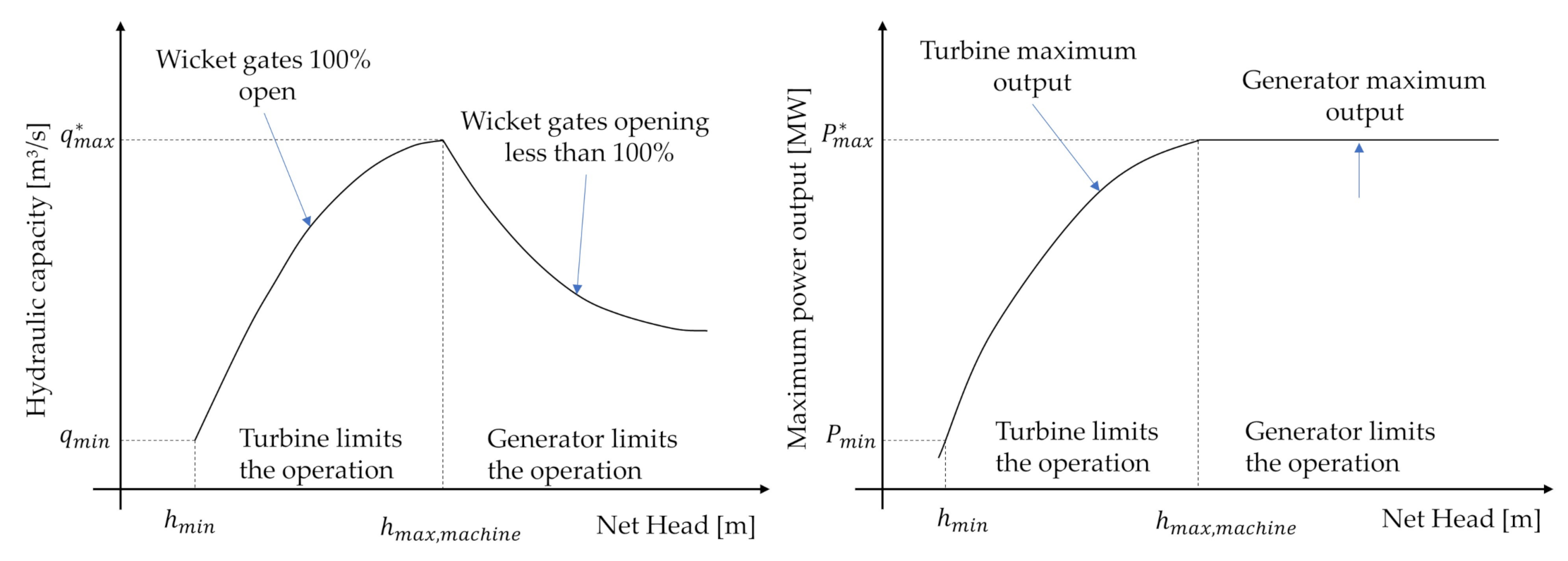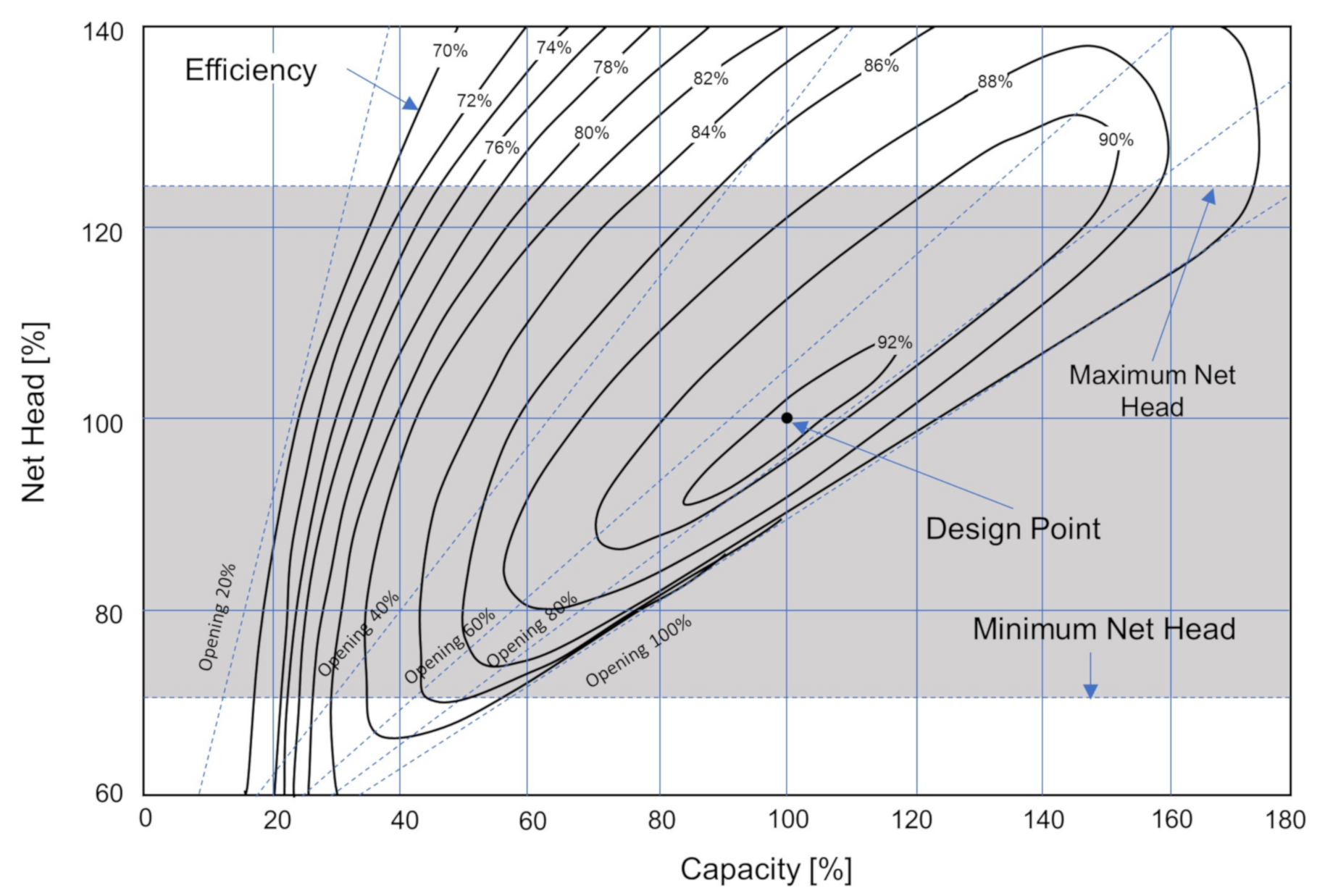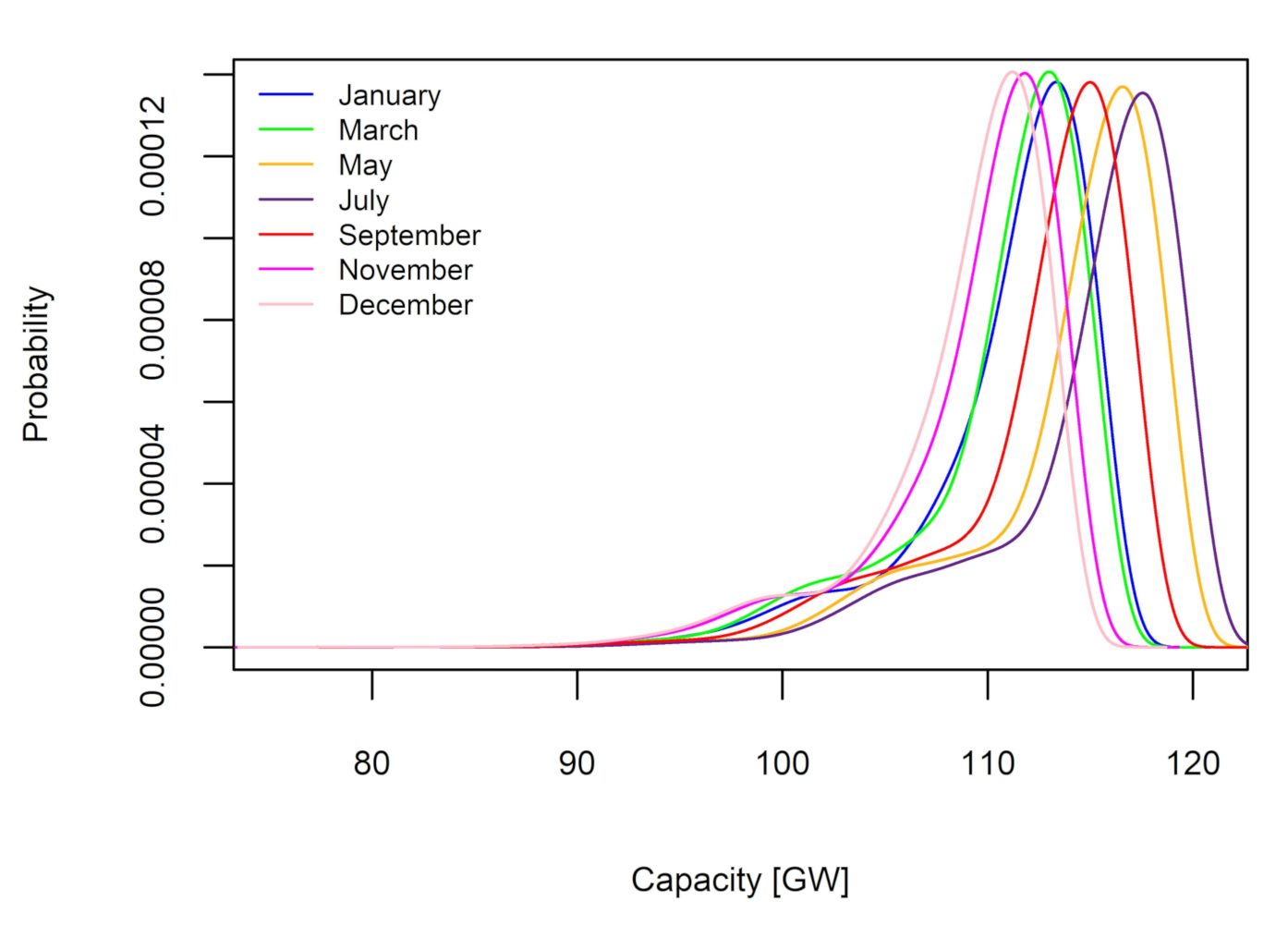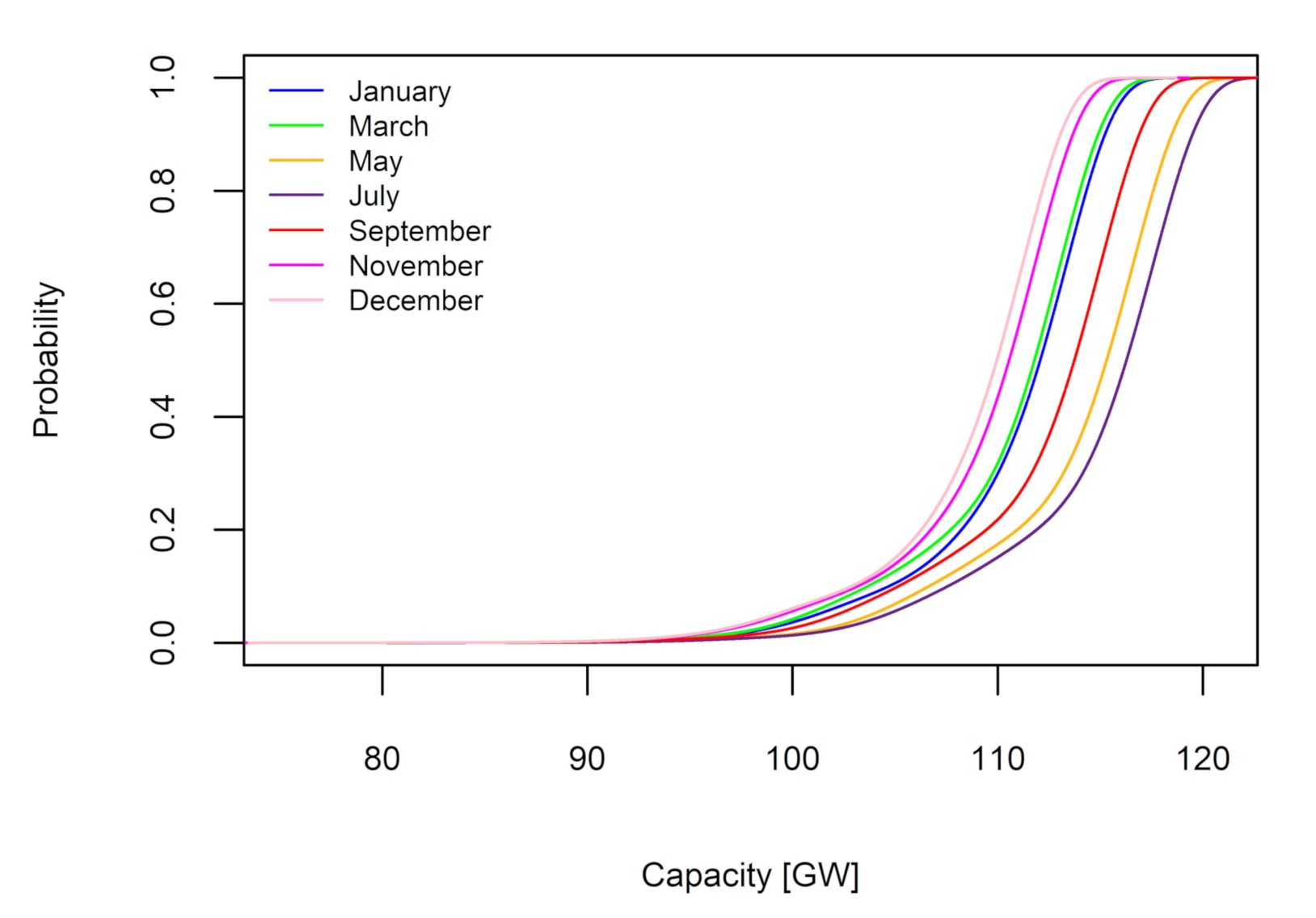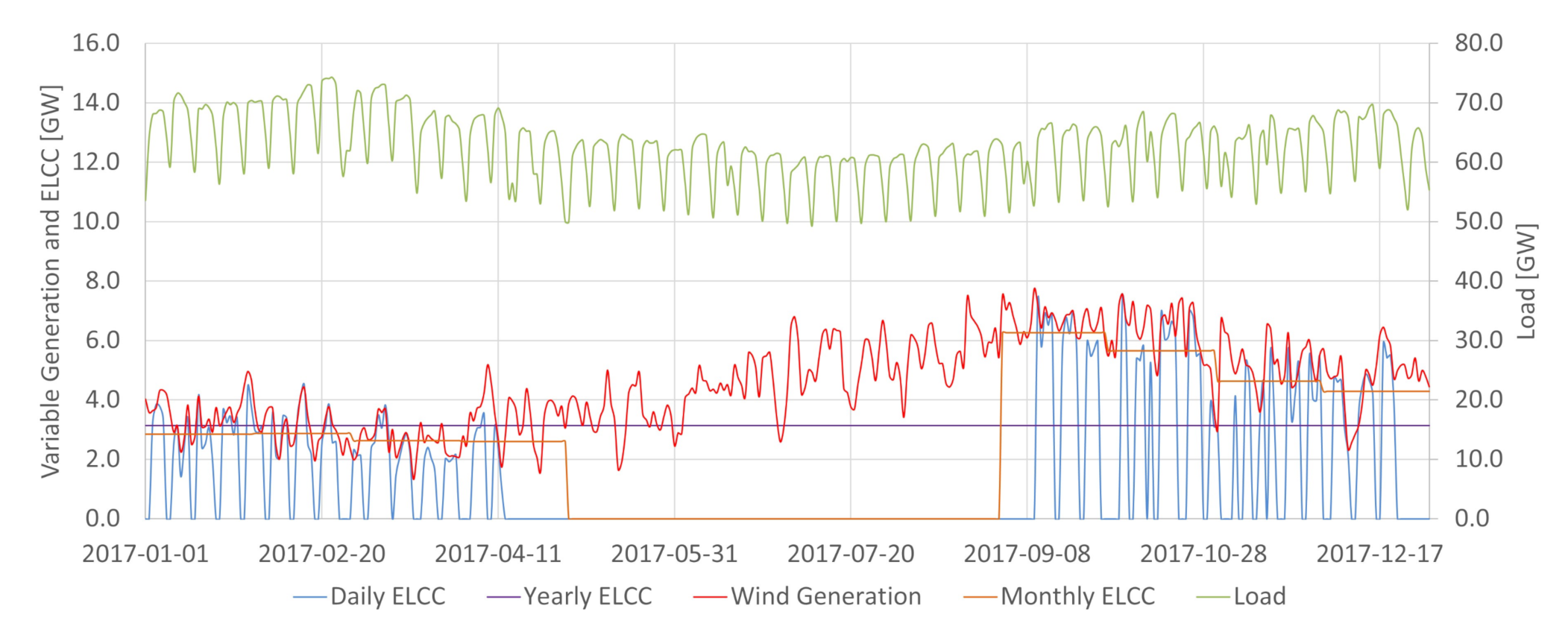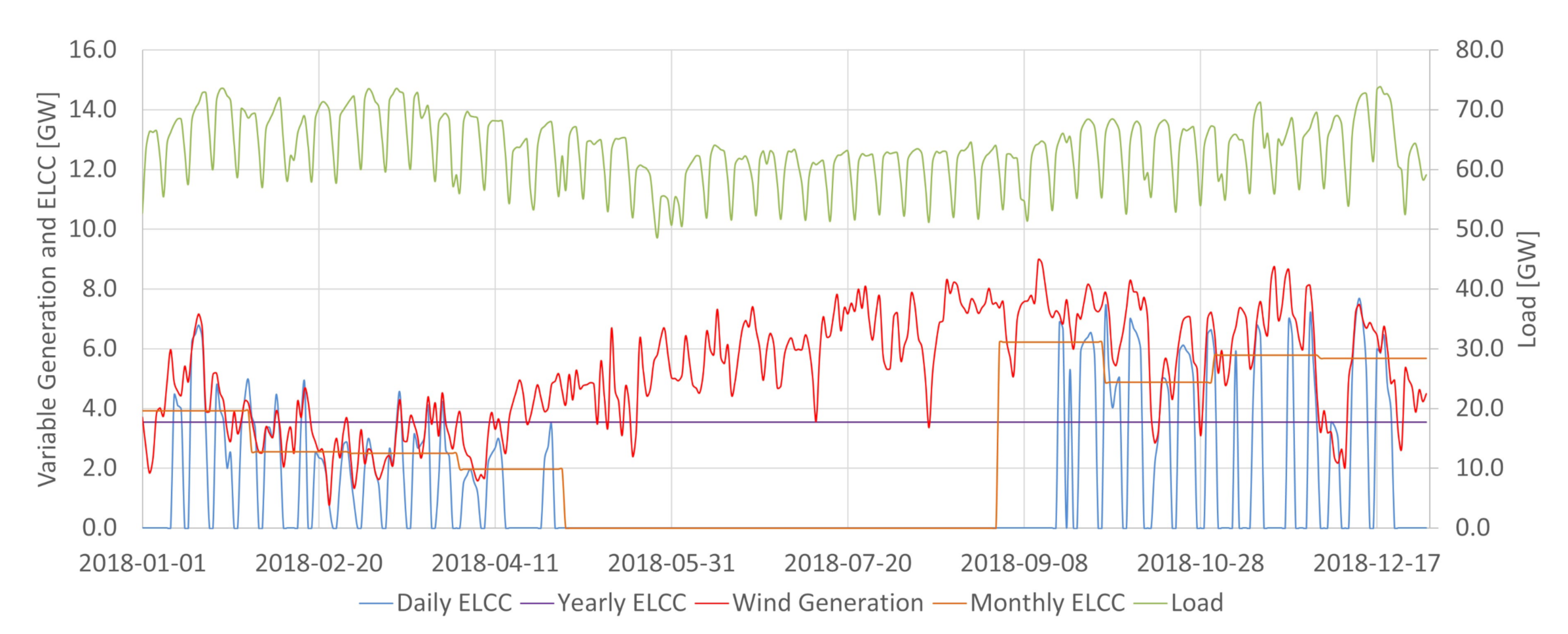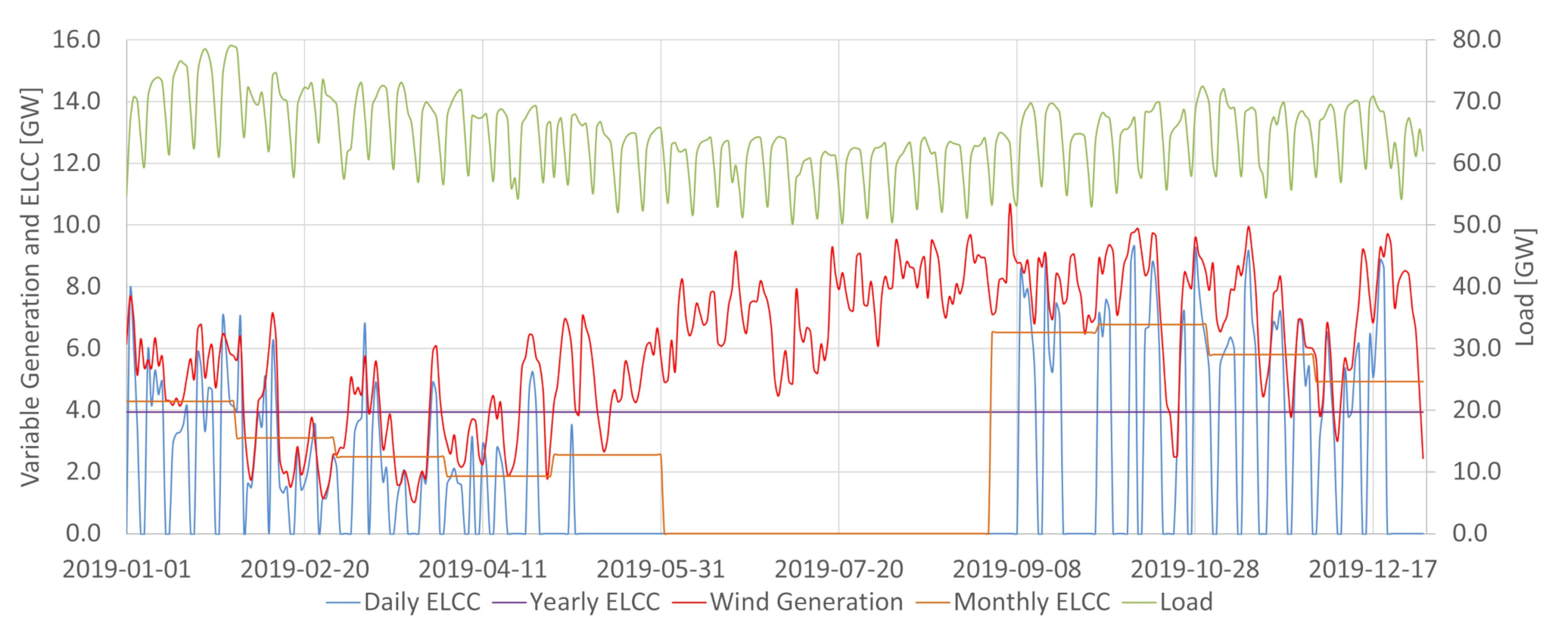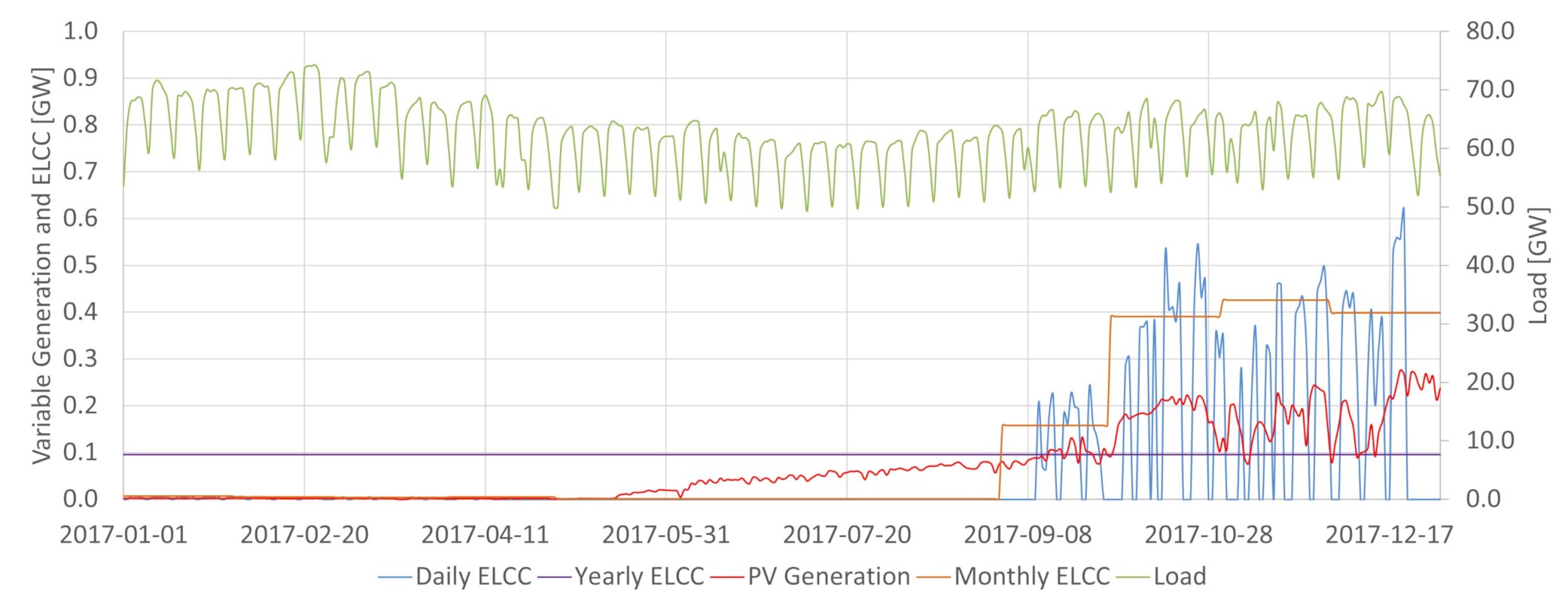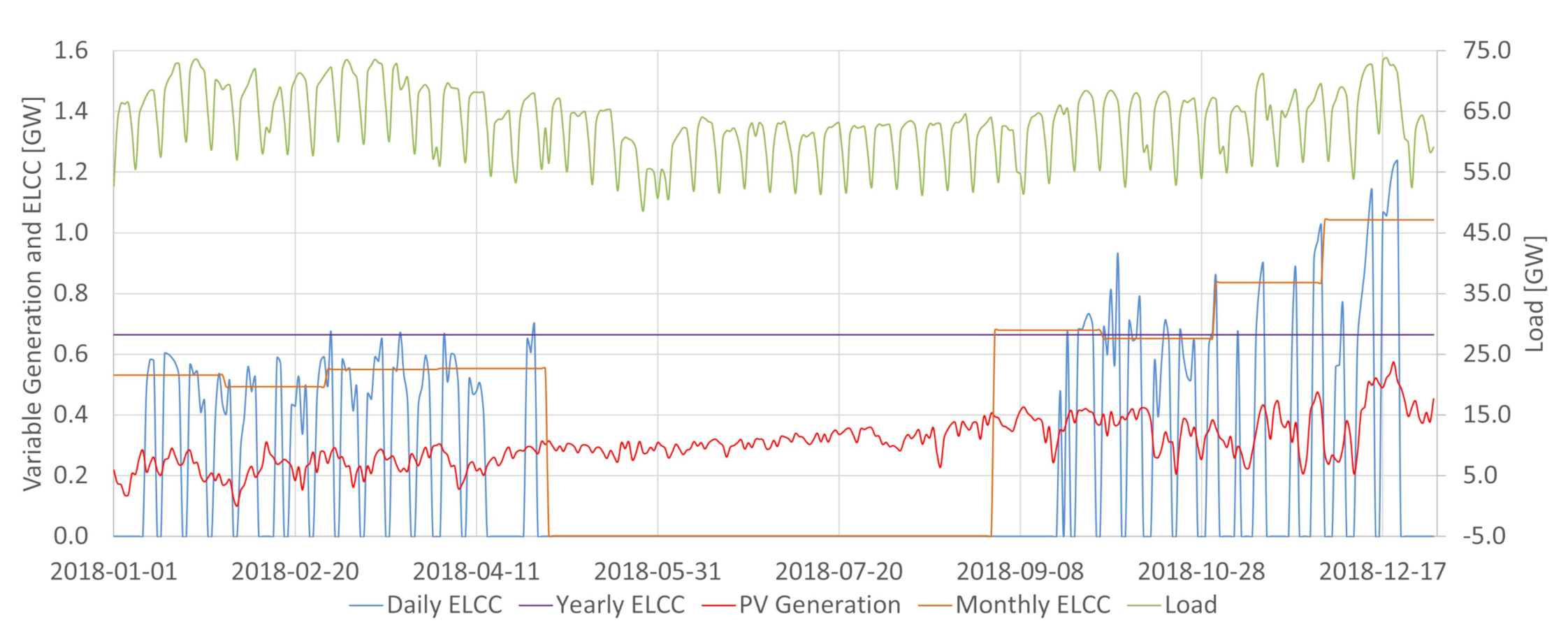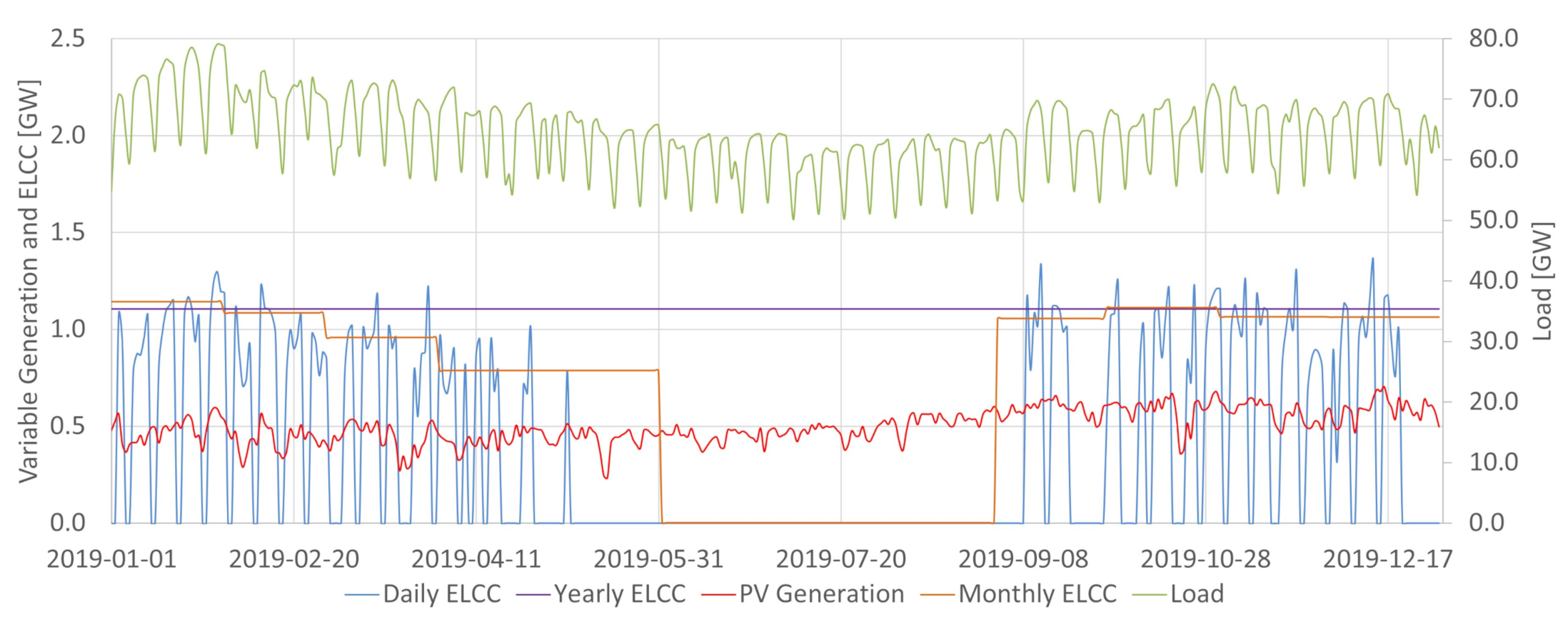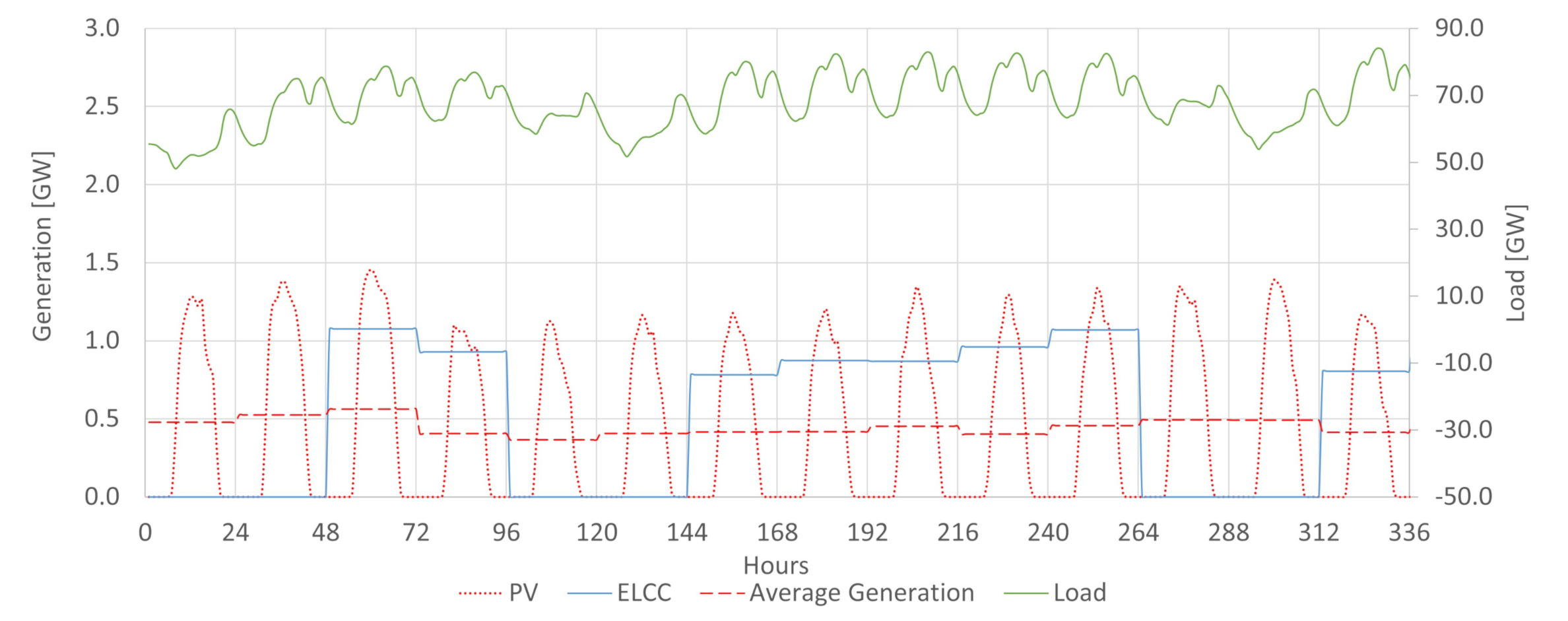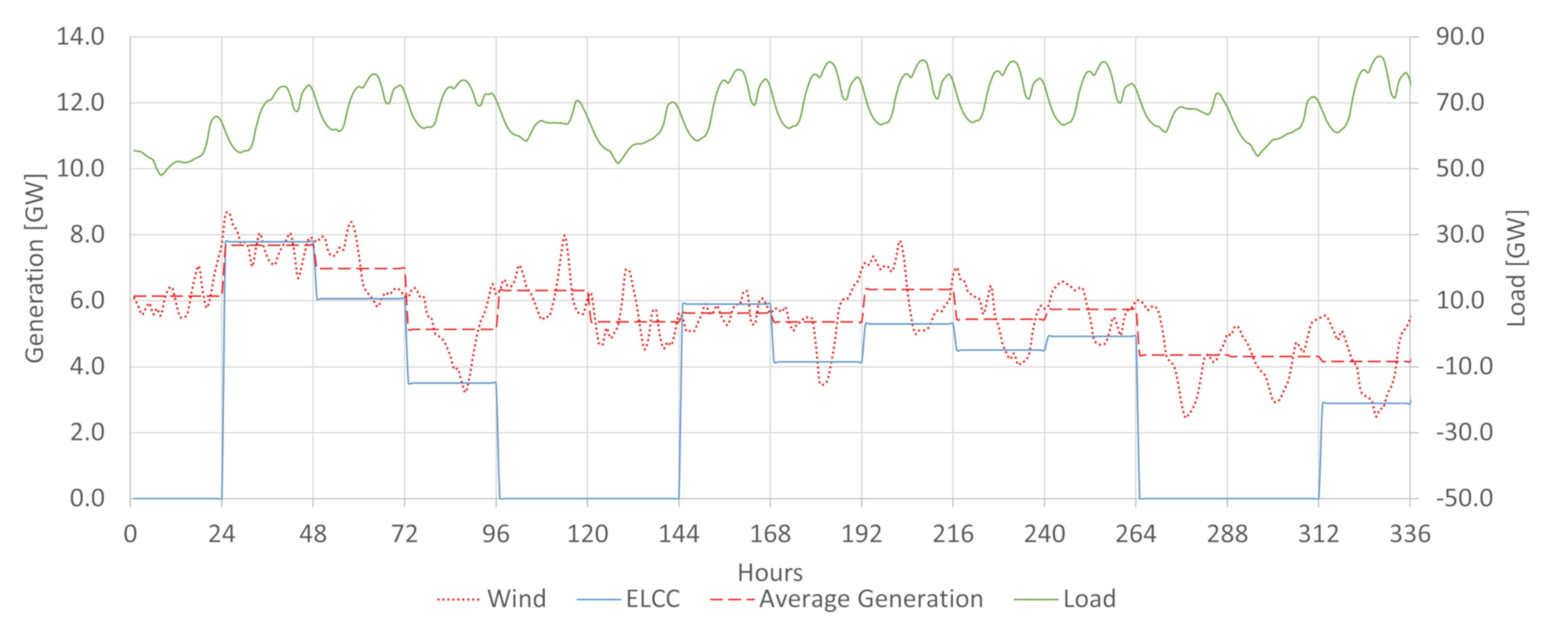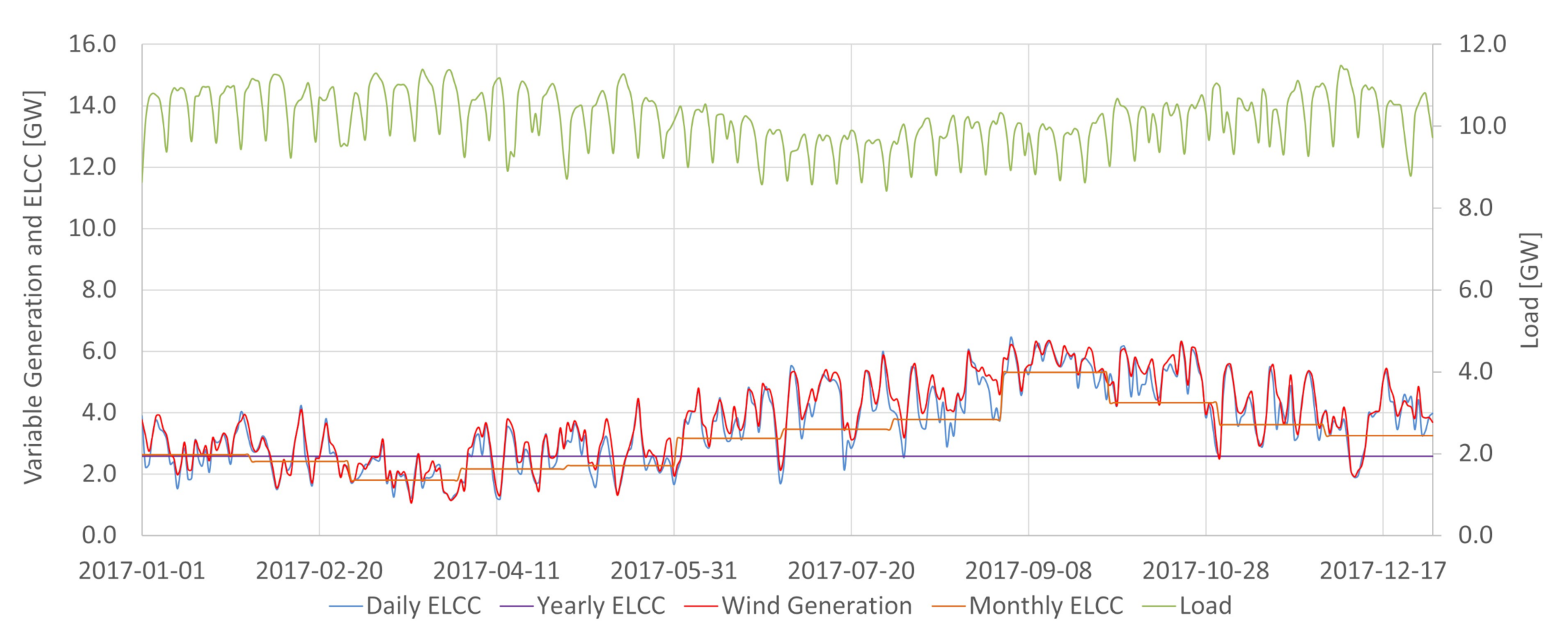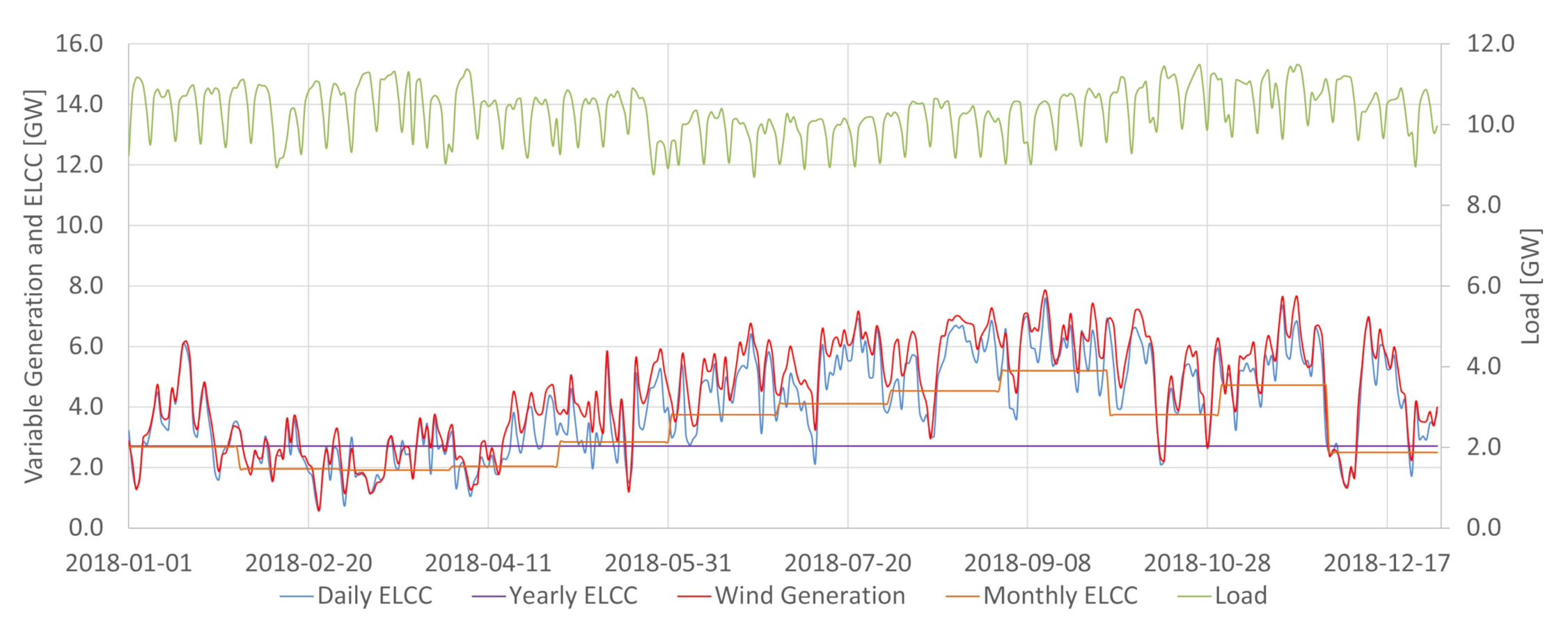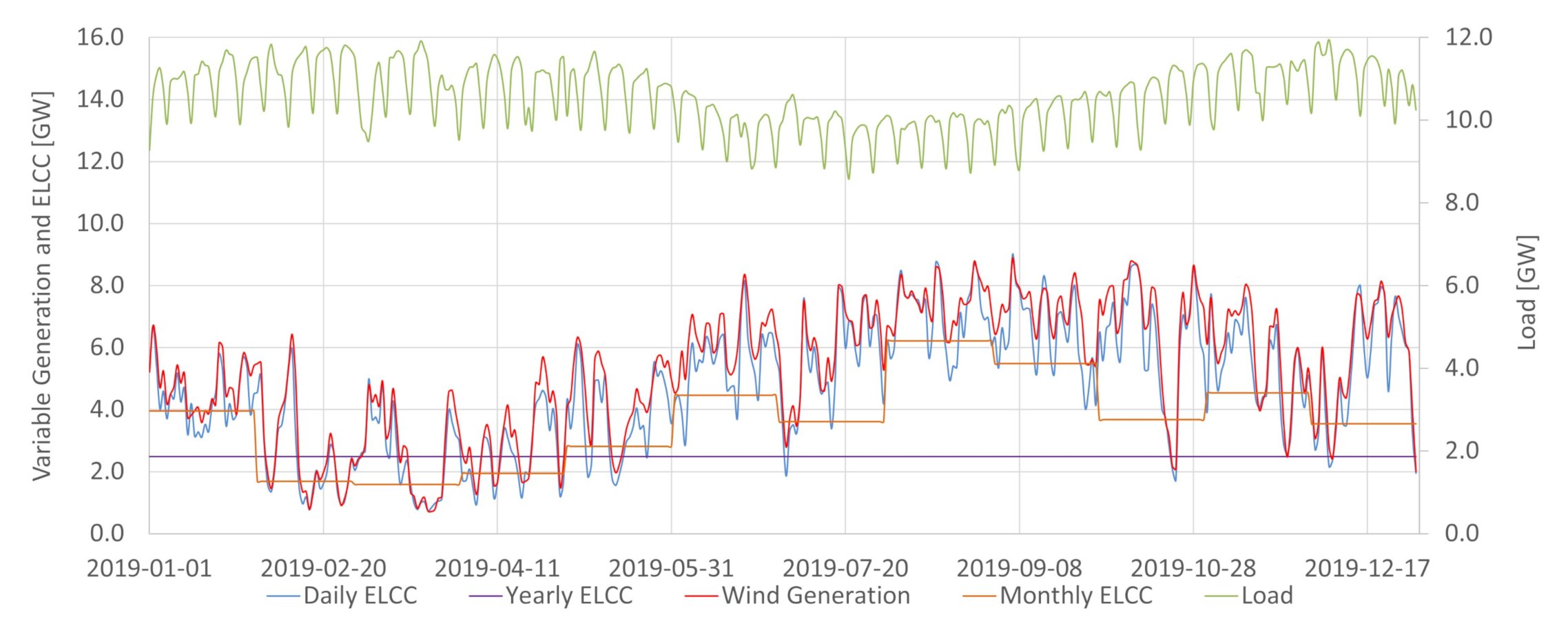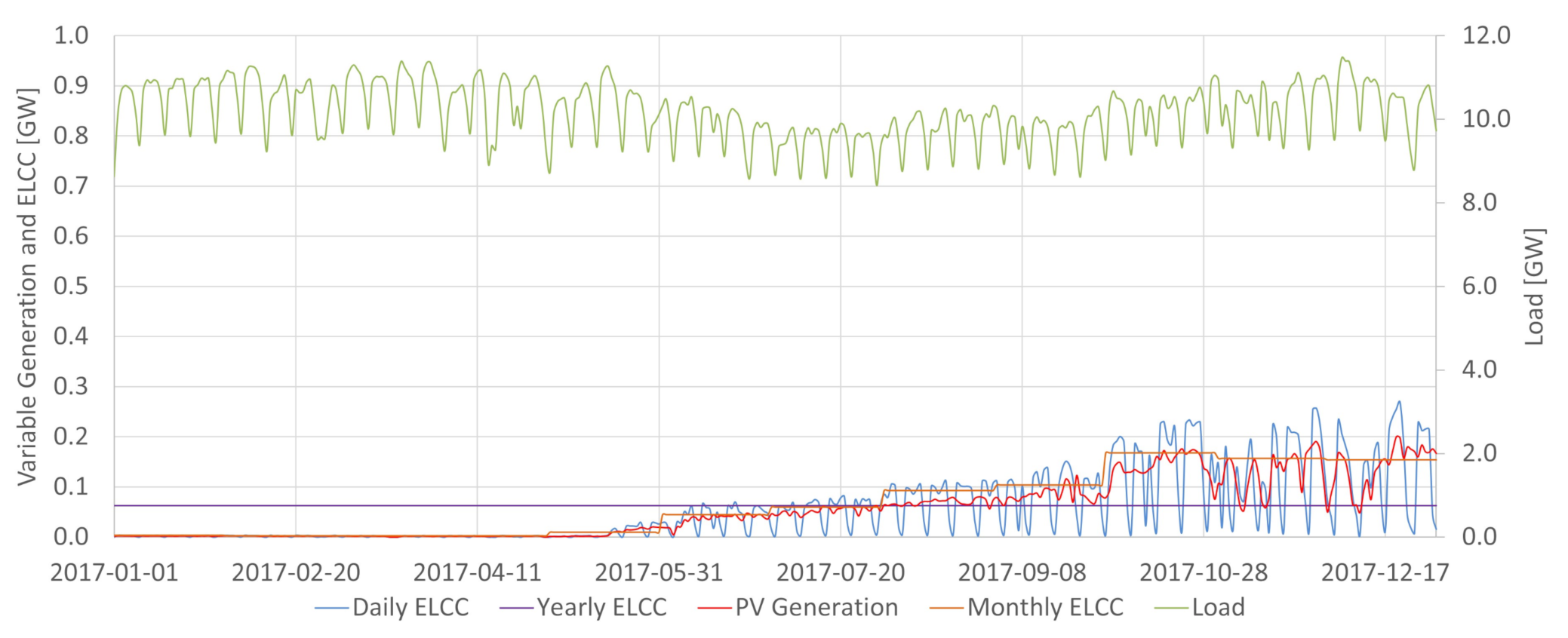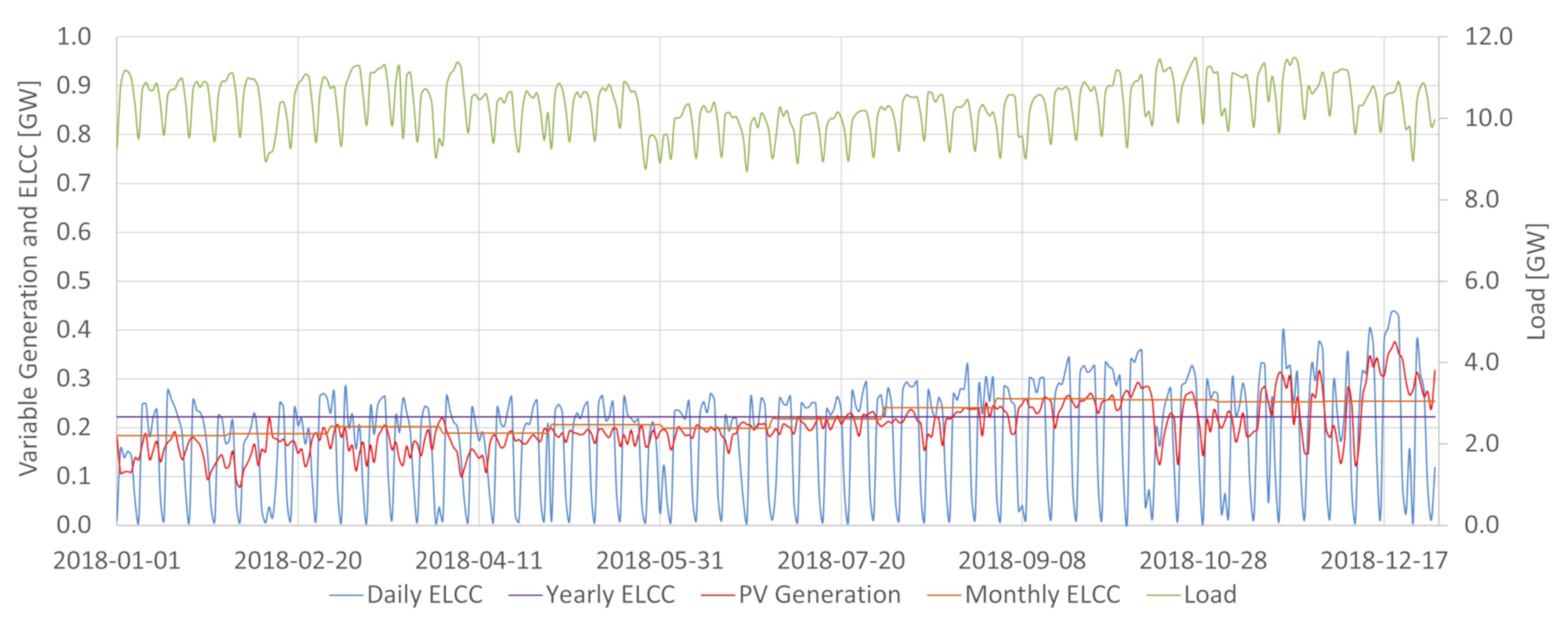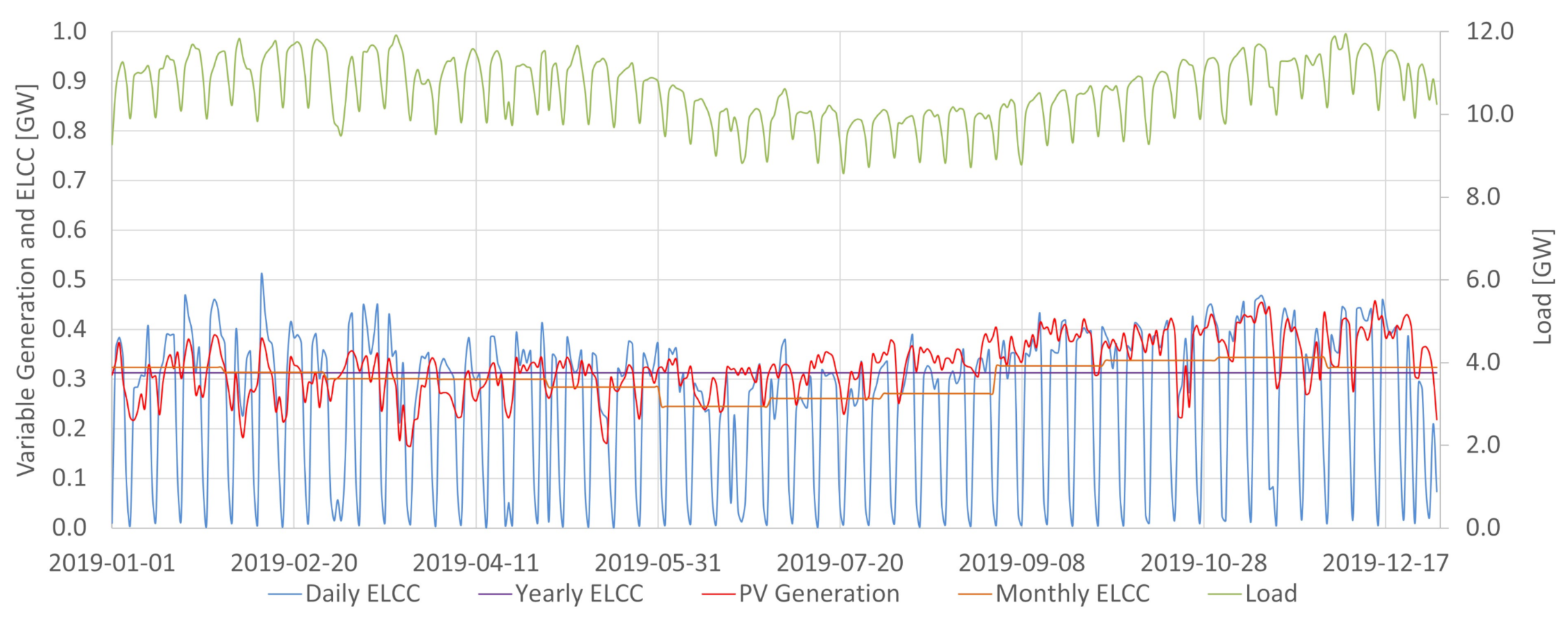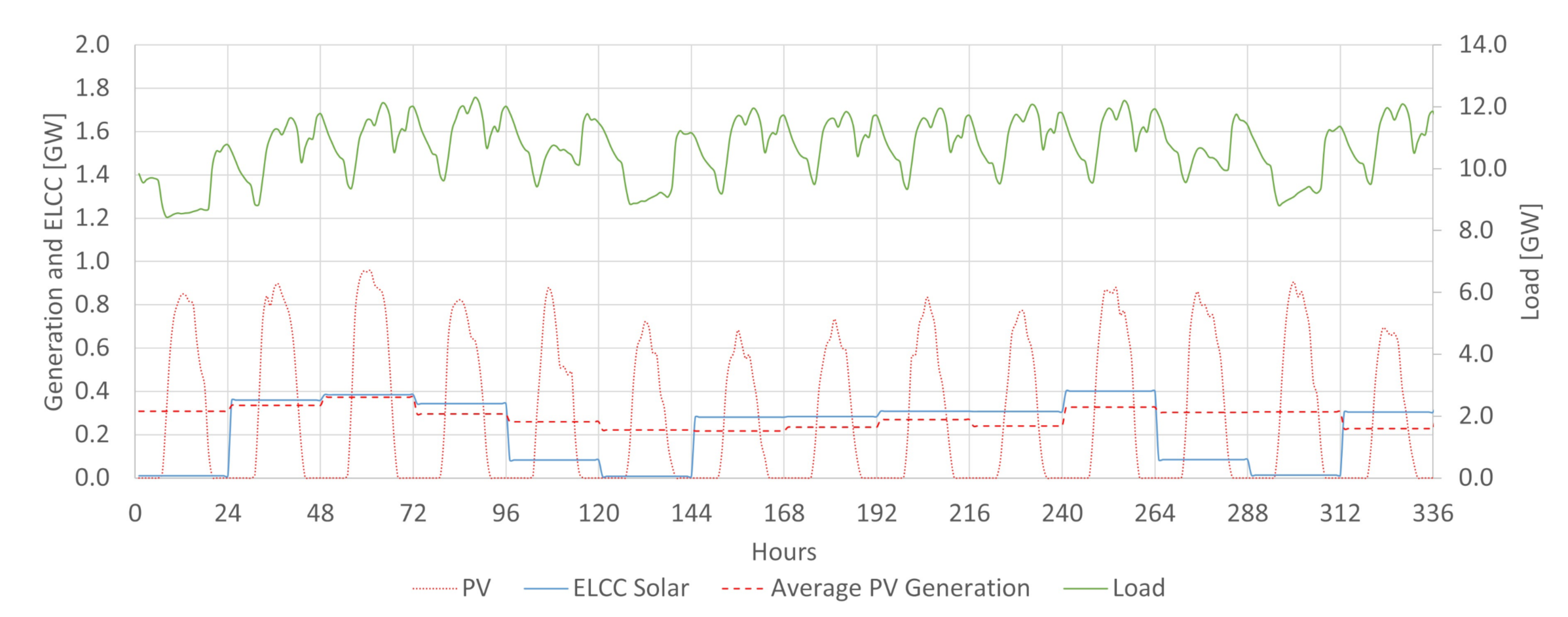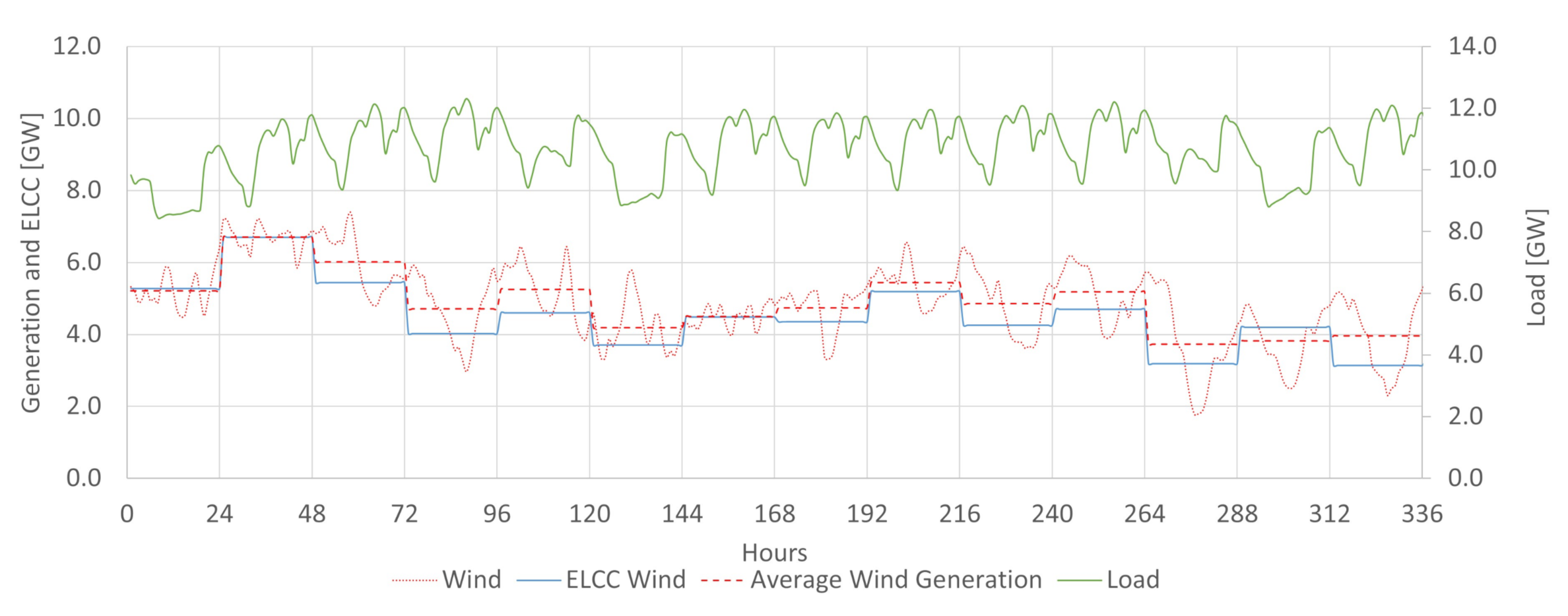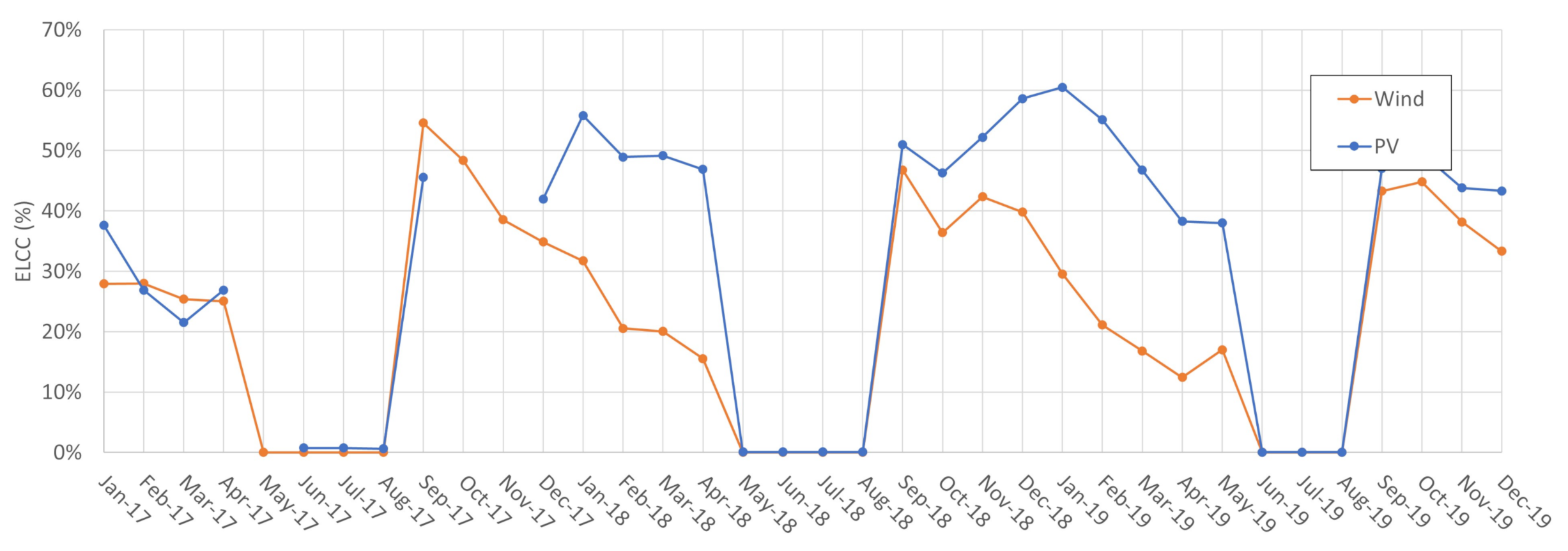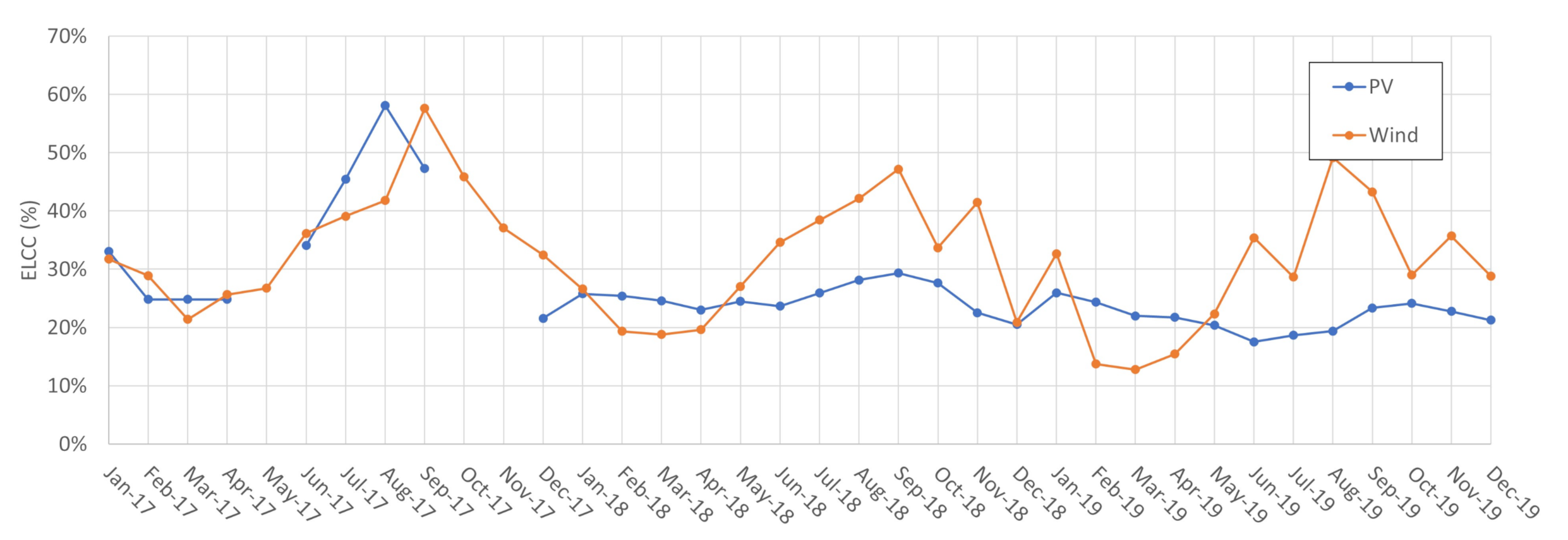1. Introduction
Energy planning and power systems operation must ensure that the load curve is met both in energy and power resources. The set of available generators must meet the total amount of energy in a certain period. It must also be able to meet any instantaneous power value observed.
In power systems made up of thermal power plants, generators’ power is equal to their installed capacity. Typically, a subset of fast-responding generators accompanies rapid variations in the power curve. Moreover, investments in overcapacity generation compensate for eventual outages. Under these conditions, it is usually possible to meet demand with high-reliability levels without the need for further reflection on how to treat the power variable in planning models.
The transition towards the use of renewable resources changes this scenario given the increasing relevance of non-dispatchable sources. Dispatchable sources have storage structures to control the outflow of electricity supplied to the power system. In thermoelectric plants, the fuel used for burning performs this function; in hydroelectric plants, reservoirs do so. The situation is different with renewable resources such as wind and solar. Investments in renewable sources, mainly solar and wind, are investments in installed capacity that will convert flow energy present in the natural system into useful energy. These resources usually do not have natural storage structures, as is the case with fossil fuels. As they make useful energy available from variable flows and not from controllable stocks, their power contribution to the electric system will rarely be equal to their installed capacity. Its availability will also be subject to more significant variation and uncertainty than the capacity value from dispatchable sources. Despite this, it is possible to determine the capacity value of sources that captures flow energy such as wind and solar.
With the increased insertion of renewable sources in the grid, interest in determining these resources’ capacity value has increased [
1,
2,
3,
4,
5]. In this context, several methods were developed and contributed decisively to fill this gap. There are two main strategies for estimating capacity value: approximation and reliability-based methods [
6,
7]. Approximation methods are less computationally intensive. These methods include Garver’s ELCC approximation [
8], Z method [
9], and capacity factor-based methods [
10]. Although approximation methods are simpler to implement, their accuracy varies [
7]. Reliability-based methods allow the description of power systems’ behavior with intermittent renewable generators more accurately but require more computational resources. These methods include equivalent conventional power (ECP) [
11], equivalent firm capacity (EFC) [
11], and effective load carrying capability (ELCC) [
7]. In this article, the analysis was performed employing the ELCC method.
Despite the progress they represent, reliability-based methods adopt the premise that dispatchable sources have constant capacity throughout the analysis period. Thermoelectric plants are taken as the dispatchable source base model. That is an unacceptable limitation for systems with a large share of hydroelectric sources. Hydroelectric plants are dispatchable sources with variable maximum power output over time, varying according to the reservoirs’ level and the rainfall regime.
Improving the representation of the contribution from flow resources (hydroelectric, wind, solar, etc.) is vital for the economic value of both renewable sources and para-renewable resources (such as storage or demand control technologies). It is necessary to quantify the level of extractable services from them. Otherwise, the level of investments in those technologies will likely be sub-optimal.
In addition to the usual concern with resource optimization, there is another important reason for energy researchers to develop new ways of representing power contribution from the sources that make up the energy mix. As already noted, this article develops a method that makes it possible to drop the dispatchable generators’ constant capacity hypothesis. This hypothesis is a substantial obstacle for all energy-limited capacity sources, such as hydroelectric, batteries, concentrating solar power (CSP), etc. In practice, constant capacity models are only capable of representing power contributions from conventional sources such as thermoelectric plants.
Significant technological advancements have taken place in energy storage [
12], demand control [
13], CSP [
14], and even intermittent energy as possible sources of flexibility [
15,
16]. However, the models used for the planning and operation of power systems continue to a large extent using premises that, although representing well enough conventional thermoelectric technologies, do not facilitate the insertion of emerging technologies to perform the energy transition to renewable sources. This article provides a contribution towards overcoming this gap by developing a method that makes it possible to calculate the capacity value of renewable sources while recognizing and incorporating the variability of dispatchable plants’ capacity. The developed method was applied to calculate solar and wind capacity value in Brazil as an exercise. As further developments, it is possible to extend the approach here proposed to other energy-limited resources capable of providing power, such as batteries and CSP.
The remainder of this article has the following structure: in the Materials and Methods section, some reliability concepts that underlie the investigation are discussed, particularly loss of load probability (LOLP) and loss of load expectation (LOLE), in the sequence it is shown how standard effective load carrying capability (ELCC) calculation uses these concepts and how they can be extended to systems with variable capacity dispatchable generators. Having introduced the method, it is applied to a specific case study, assessing solar and wind sources’ capacity value for Brazil and for the Northeast region. The obtained results and the implications of the developed method for planning and operation are discussed in
Section 4. Finally, in
Section 5, the conclusions of the work are presented.
2. Materials and Methods
In this section, reliability concepts are discussed and incorporated into the presentation of the standard calculation of effective load carrying capability (ELCC). After that, it is shown how to calculate ELCC with variable capacity dispatchable generators.
2.1. Reliability Concepts
Typically, system reliability is measured using loss of load probability (LOLP) and loss of load expectation (LOLE) indicators. Although LOLP is a probability, LOLE is an expected value. At each moment, the likelihood that a set of generators does not meet a certain load level is the probability that the total available power from such generators is less than the load level at the time interval in question. A specific generator in the generators’ set may not be available either due to failures or scheduled shutdowns. In both cases, there will be unavailability.
For forced shutdowns, it is being implied that generators could assume only two possible states, total unavailability versus total availability. These possibilities determine a forced outage rate (FOR) as shown in Equation (
1) [
17]:
However, in reality, generators unavailability is more complex given that a particular generation unit can be operating in de-rated states. Therefore, a unit’s possible capacity states are not only total availability or total unavailability, but it may also have many intermediate levels of reduced availability. It is not always obligatory or feasible to work with all these possible states [
17]. To take them into account and at the same time limit the complexity of the investigation, it is a common practice in reliability studies to use the equivalent forced outage rate (EFOR) which can be understood as the equivalent probability of a unit being on forced outage at some distant time [
17]. This equivalent probability is calculated using [
18]:
where:
—Capacity of generation unit
i,
—Forced outage hours,
—Equivalent unplanned de-rated hours,
—Service hours,
—Outage for external conditions hours,
—Shutdown reserve hours,
i—Generation unit of the plant,
I—total of generation units,
j—Month.
is calculated considering the last 60 months as defined by [
18].
To complete the availability measurement, it is also necessary to take into account the scheduled maintenance. The system stops in consequence of a failure and for a programmed interruption or programmed de-rated generation. To account for this, it must be included the Equivalent Programmed Outage Factor (EPOF) as proposed in [
18]:
where:
—Planned outage hours,
—Equivalent planned outage hours,
—Period hours.
is calculated considering the last 60 months as defined by [
18].
Ideally, the availability calculation for each sub-period (day, week, etc.) should consider the maintenance schedules, as indicated in [
19]. Unfortunately, the maintenance schedule for each plant that participates in the Brazilian market is not available. To deal with this situation, it was decided not to differentiate between forced and programmed outages, a risk-averse and conservative position. The proposed approach underestimates the plant’s availability because the programmed event takes place only in a particular time interval while the forced outage can take place at any given time period during the analyzed time horizon.
The National System Operator (ONS) provides data for the conventional dispatchable generators regarding the EFOR and the EPOF. The total unavailability of a specific unit is the combined effect of forced outage and the programmed outage events:
In this study, the unavailability provided by Equation (
4) was used to take into account the forced and the programmed outages.
After accounting for each generator’s unavailability, it is necessary to evaluate the generators’ set aggregate risk. The fundamental instrument here is the capacity outage probability table (COPT). This table presents the probability of existence of each possible capacity level (or state) formed from the combination of all generators that comprises the generation park and presents the respective available capacity of each of these states [
17]. In COPT, each line is always referred to a particular combination of availability and unavailability of all considered generators, which yields what here is being referred as capacity level or state.
Table 1 shows a generic COPT and [
17] details the algorithm to obtain it.
represents the capacity
C of capacity state
n of the set of generators, while
indicates the probability of existence associated with each capacity state and
represents the accumulated probability of all states up until state
n.
N is the total number of capacity states that a particular set of dispatchable generators can assume. Therefore,
will be equal to 1, as all the probabilities of the sample space are being summed. System failure probability during a sub-period
t is the sum of all state probabilities in which available capacity is less than load at sub-period
t. The sum of all events probabilities in which
<
determines
[
7]:
with:
The assessed failure probability measure for each sub-period
t allows evaluating the capacity shortage risks in period
T (where
T is the whole time horizon analyzed, while
t is a subset of
T) using LOLE indicator (loss of load expectation). By definition, the expected value of a random variable is the average of the values it can assume, weighted by the probability of each of these values, i.e., the expected value of a random variable
X that accepts values
is:
where
is the proportion of times the variable
is observed in the total number of observations
.
Suppose that to analyze the system’s operation during a specific period it is discretized in sub-periods of the same size
t. In this article, one year period is divided into 8760 one-hour sub-periods
t. By doing so, the expected value of load loss hours will be:
By discretizing the period of analysis in equal unit sub-periods, LOLE is the sum of the observed LOLPs. Therefore, the failure probability in each sub-period
t impacts LOLE. As
t is in hours, LOLE is measured in hours in this case. Another remark about LOLE is that, as shown in Equation (
9), it is an value that must be interpreted as mathematical expectation of the load loss in time units and indicates the average number of hours that will present a loss of load event [
17]. It must not be interpreted as frequency of events or with any duration connotation [
17]. A final remark about LOLE is that it may be in hours, days or others possibilities depending on the discretization of the employed time series on the analysis.
2.2. ELCC Standard Calculation
The effective load carrying capability (ELCC) is a measure of the generator’s contribution to reliably meet the load curve. To determine the ELCC of an intermittent source the following procedure is adopted: first, the LOLE is calculated considering only the dispatchable generators (Equation (
11)), then one or more intermittent generators are added to the system (Equation (
12)). After that, LOLE is recalculated and since the load was kept constant and more generation capacity was added, the reliability increases and, consequently, the LOLE decreases. Now, there is a difference in LOLE prior and after the addition of intermittent generators. Then, the final step is performed, and virtual load is homogenously added to all sub-periods of the load curve up until the LOLE reaches back its original level before any generator addition (Equation (
13)). The value of the added virtual load that makes the resultant LOLE equal to the prior level is the ELCC.
The steps required to calculate ELCC are summarized in Equations (
10)–(
13). For a given set of conventional generators, the LOLE of the system without the intermittent generation is:
The summation from to N refers to the sum of all COPT lines and the summation from to T refers to the sum of all sub-periods within the assessed period.
After the addition of the Variable Generation (VG) to the system, the standard ELCC procedure requires LOLE recalculation. The
will be lower than the LOLE of the base system because extra generation capacity was added with no change in the load curve:
is the new plant’s generation delivered at hour t. The global impact of this new generator depends on its effects on all hours t. The − term is the Net Load after the addition of the VG. In this context, the dispatchable generators fleet is responsible for meeting the load portion not met by variable generation, i.e., for each hour t, the dispatchable generators must supply −. The smaller this difference (Net Load), the less reserve margins are required from dispatchable generators; therefore, the lower the probability of failure at this time ().
Traditionally, the power system faces a higher risk of loss of load in a few critical hours (peak hours in conventional power systems). At these times, the difference between the dispatchable generators park’s capacity and the demand level is minor, so it can be challenging to find generators to compensate for a possible failure in these critical moments. In other words, the reserve margin in these moments is low. That is why between two VG sources that provide precisely the same amount of energy over a given period, the one which contributes more on critical hours contributes more to the adequacy of supply, as it provides power in times of greater risk. The addition of a new VG generator impacts hours
t, reducing LOLE so
. The more significant the impact of installed capacity of
in hours
t (especially in the critical ones), the more relevant the global effect on LOLE. The effective load carrying capability is the increment load
D that makes the system’s reliability level before and after the VG generator’s addition equal.
D is determined by applying Equation (
13) iteratively varying
D until the established criteria of equal LOLE is attained.
D is the load added each sub-period. Computationally, D is found by adding equal increments of virtual load to all sub-periods t until the LOLE obtained with the new VG added is the same as the original. The D value is the load increase, which was possible due to VG addition in the power system while maintaining the system’s reliability. This value D considers the impact of the new VG on all sub-periods t, and it corresponds to the VG’s ELCC.
2.3. ELCC with Variable Dispatchable Capacity
The preceding discussion in
Section 2.2 indicates that the entry of a new generator acts by reducing the probability of capacity shortages in sub-periods
t. It also shows that the inserted generator impact does not occur homogeneously or linearly. Even if the generator produces equal increments in all sub-periods
t, the observed reduction in failure probabilities
will not be distributed evenly over the new generator’s operation period. This reduction is more significant if this generator operates when reserve margins are low. In short, the new generator’s contribution to meet the load will depend on the risk the system faces when it actually delivers power.
Traditionally, in studies that calculate intermittent sources’ capacity contribution using reliability methodologies [
7,
10,
11], it is assumed that dispatchable generators’ capacity is constant throughout the investigation period, i.e., it is considered that the state of the dispatchable generators does not change. Therefore, the COPT is the same during all analyzed sub-periods (hours, days, weeks etc.).
For systems that operate predominantly with thermoelectric plants, the supply of fuel can be considered unlimited when there is adequate logistics infrastructure. In this context, the hypothesis that dispatchable generators’ capacity is always equal to their nominal capacity is sufficiently robust. Although normally acceptable, there are circumstances in which the hypothesis that the thermoelectric generation capacity is constant throughout the year does not represent the system’s behavior adequately as analyzed by [
20] ([p. 11]): “ISO-New England and PJM have observed that their markets are not attracting resources needed during extended periods of cold weather. Gas generators who commit to provide capacity do not necessarily have firm pipeline supply contracts, and dual fuel units with onsite oil storage may not have sufficient fuel to last for more than a week, especially when there are competing uses of that fuel and weather-related forced outages that can disrupt supply from multiple generation sources. PJM reports high coal plant failure rates in 2014 and 2018 cold weather episodes”.
In predominantly thermoelectric systems, the capacity variation of dispatchable thermoelectric plants throughout the year is usually only a fine adjustment in the model. However, in systems with a more significant share of hydroelectric resources, it is essential to consider how the dispatchable available power changes over time. In this case, the hypothesis that dispatchable capacity is constant is far from the truth. In these systems, there may be considerable intra-year and inter-year variations [
21,
22,
23]. Not surprisingly, whenever the dependence on flow energies such as hydroelectric, wind, and solar increases, there is a need to describe the power system in more detail [
24,
25].
Therefore, how to proceed in cases where dispatchable generators’ capacity cannot be considered constant? First, it must be observed that although hydroelectric generators’ capacity is not constant throughout the year, it is possible to identify sub-periods
i in which the capacity of these generators varies little or does not vary at all. Therefore, the dispatchable generators’ status can be adopted in each sub-period
i to construct a respective
. For clarification, it must be noted that sub-period
t denotes the discretization that the generation and load data are available from the National System Operator’s database while sub-period
i, which is greater than sub-period
t, denotes a time interval when the capacity of hydropower can be acceptably considered constant. For this study,
t is discretized in hours and
i in days. With
, which is the COPT of each day
i, the generation data of the intermittent source and load curve in each hour
t, the loss of load probability in the sub-period
t can be determined as
, which is understood as the probability of not supplying a particular load level that takes place at hour
t that is comprised in day
i.
In Equation (
14), it can be seen that there is a particular COPT for each sub-period
i. The procedure for the LOLE determination with daily COPT recalculation is as shown:
where
to
represents each line for each one of the 365 COPTs. For each day,
i assumes a value between 0 to 364 and
t assumes a value of an hour of that particular day. The term
is determined using the specific COPT for that day (
). The LOLE for the whole period will be the sum of the
LOLPs of each hour of each day as show in Equation (
15):
That is,
. This suggests that generally
, where
t/k is the integer division of
t by
k, and
k is the number of hours comprised in a day. For cases of practical importance and considering a park with a COPT of
N lines, the LOLE calculation equations are:
In the above equations, LOLE is evaluated for one year period. However, it is possible to change period evaluation and the other parameters accordingly. For example, studying intra-hour demand and intermittent behavior could lead to choose new values for i, t and k accordingly. As long as the choice captures the quasi-constant dispatchable power behavior, parameters for the sub-periods i, t and k can be specified.
In short, considering the variable capacity of dispatchable generators requires evaluating the COPT table in each sub-period i. This procedure does not require conceptual changes in the current practice of supply adequacy studies. Even so, it makes the meaning of the ELCC clearer. It makes explicit that the ELCC is a measure of the intermittent source’s capacity contribution throughout the period vis-à-vis the load level and the status of the dispatchable generators in each of the moments that comprise the period. In the analysis with dispatchable thermoelectric generators, this is less clear due to the constant value premise of these generators’ capacity.
Figure 1 summarizes the developed method to aggregate the standard ELCC calculation with hydropower modeling enabling the capacity value determination when the dispatchable generation has variable available capacity.
The method is comprised of three steps: Data Gathering, Hydro Modeling and ELCC Determination. In Data Gathering the hourly load curves and VG’s generation curves were obtained from the National System Operator (ONS) database [
26], the hydropower and thermal plants’ design data are obtained from the NEWAVE datasets [
27] (NEWAVE is the official computational optimization tool employed to guide the operation of the Brazilian hydrothermal electric system), EPOF and EFOR are periodically calculated by the ONS and are available in its database [
28]. For the daily parameters of hydropower plants both the database of ONS or National Water Regulatory Agency (ANA in Portuguese) have this data [
26,
29]. After all data are gathered and organized, the Hydro Modeling step takes place. The method described in
Appendix A is employed to determine the daily capacity availability of each hydropower plant modeled. After that, given that the assessed period is one year (2017, 2018, 2019), 365 COPTs are calculated. The ELCC Determination starts with the load and VG’s curve as input and the procedure described in Equations (
11)–(
13) is adopted. Actually, those equations refer to the standard ELCC calculation, so the actual employed equations are in the form of Equation (
16), to mathematically incorporate the daily variability of the COPT, but that put aside, conceptually, the procedure is exactly the same of Equations (
11)–(
13).
4. Discussion
The ELCC simulation indicates the VG’s contribution to resource adequacy. With increasing penetration of intermittent sources, it will be a vital parameter to subsidize energy planning and system operation. In the past, different energy sources were characterized basically by their rated capacity and their capacity factor. Those parameters were enough to infer generator power contribution. This situation has changed with a growing share of non-dispatchable sources. Comparing variable generation sources requires a greater level of detail. For example, a wind plant and a solar plant, both with the same rated capacity and capacity factor, can still contribute differently to resource adequacy if their generation profile differs at critical hours. This possibility is very relevant to orientate energy planning and power system operations in the current context. It is increasingly necessary to effectively measure the capacity contribution of different generation sources, notably the intermittent ones. It requires considering the inserted generation profiles of these sources and load profiles, and all conventional dispatchable generation features.
The ELCC method, among others, has provided an essential advancement in the task of adequately measuring the capacity contribution of intermittent generation. Without this accurate measurement, the economic value of the intermittent sources decreases because only their energy contributions are accounted for. Besides that, without determining capacity contribution from variable sources, it is impossible to determine the optimum level of investment necessary to assure resource adequacy. This situation can lead to excessive risks or over-investment in dispatchable power (often with non-renewable sources). Both paths are undesirable in economic and environmental terms.
Despite its advancements, the ELCC implementation has been limited so far to systems with constant dispatchable capacity. In practice, the premise of constant capacity makes it impossible to evaluate capacity value from variable sources in systems with high participation of hydropower since hydroelectric plants are dispatchable, but their capacity changes over time. In reality, the constant capacity premise captures only the characteristics of conventional power sources, such as thermoelectric plants. In practice, it makes the models used in the planning and operation of power systems unable to represent characteristics of energy-limited resources, including hydroelectric plants and any other flow-dependent resources, such as batteries and CSP. In practice, staying attached to models with no energy-limited variables means making a complete transition to renewable sources unfeasible.
In the Brazilian case, hydroelectric power plants are energy-limited resources essential for providing energy, power, and ancillary services. The integration of increasing levels of variable renewable generation in Brazil requires the detailed characterization of the conventional dispatchable sources to assess potential synergies between them and the intermittent renewables. As shown in
Figure 2, the available potential capacity changes daily in Brazil due to the large share of hydropower. The system may be more vulnerable in periods where conventional power is less available. For the same demand, if less conventional power is available, 1MW of variable generation tends to add more ELCC to the system than in situations where conventional power abounds. It is a possibility captured by the ELCC, which considers whether extra power is being generated in times that increase the system’s reliability. For that reason, having the proper characterization of the conventional availability power is crucial in obtaining ELCC values close to the actual contribution towards the reserve margin of a particular variable generation source. This work achieved so by incorporating the hydropower plant availability capacity method obtained in [
32] for each day to determine ELCC.
Figure 20 and
Figure 21 give an insight as to how the ELCC results can be a tool to orientate energy planning.
Figure 20 indicates that the PV capacity credit (ELCC measured in percentage values) is higher than wind capacity credit. This relevant result should be read carefully. First, it is important to notice that each source can provide three major contributions to the power system: energy, capacity and ancillary services. In the specific comparison made, in the current state of PV and wind deployment, the marginal expansion of PV provides more capacity contribution to the system than wind expansion. However, this is only one side of the issue, as the whole contribution to the system of a particular source must be assessed to determine the energy planning. In the Brazilian context it is also important to note that each renewable energy unit produced saves water in hydroelectric reservoirs, and this water will become power in the future. This situation implies that capacity credit and capacity factor of renewable sources should be both integrated in Brazilian energy planning.
There are two factors to explain the greater capacity contribution of PV during the assessed period in the SIN. First, it must be noticed that those sources have different penetration levels in the SIN. In December of 2017, Wind generation comprised 7.9% of the total installed capacity, while PV only 0.6% [
26]. It is known that, for a given load level, renewables’ capacity contribution is higher with lower energy level penetration [
7,
33]. Therefore, the lower solar penetration tends to increase capacity credit from that source. The second factor is the shift in the peak hours that Brazil has experimented given the increasing relevance of air conditioning systems use. Presently the peak hours occur during the late morning until approximately 15 p.m. This parcel of the load tends to be highly aligned with the PV generation, which increases the ELCC of PV power in the SIN context.
It is also worth mentioning that there is no permanent advantage throughout the year from one source to the other. The geographic scope is extremely relevant when assessing that matter.
Figure 21 shows that PV and wind have a complementary behavior in the Northeast subsystem context. In the beginning of the year, from January to April, the wind resource capacity credit is lower, and PV power has a greater capacity credit than wind. For the rest of the year, the situation inverts and wind tends to have a greater capacity credit than PV. Therefore, during the first months of the year PV adds more relative value to the system, in terms of ELCC, and throughout the rest of the year wind is more relevant. This behavior is explained by the fact that in this analysis, the Northeast subsystem was considered to be being fully isolated from the rest of Brazil. In that way, the available dispatchable generation in that subsystem is relatively lower than in average terms in the national context. This being so, the Northeast subsystem, as modeled in this study, is much more fragile to power shortages in a way that a greater number of renewable generation hours comes to aid the system in risky periods. That situation implies that the ELCC of the renewables ends up following closely their generation during the whole year and that is why in the beginning of the year the capacity credit of PV is greater than wind and this situation inverts when wind generation increases from May to December.
Although ELCC measurements certainly are important for planning and operations of power systems, it should be used as an auxiliary tool along with other indicators. Possibly, ELCC is even more important for power system operations than for planning. The current procedure for reserve allocation in Brazil adopted by ONS allocates the primary reserves as 1% of the generation responsibility of a particular control area; the secondary upward reserves comprise 4% of the load of the control area added to a fixed parcel to account for the wind variability [
34]. For the secondary downward reserves, the values are 2.5% of the load summed with the wind variability parcel [
34]. The wind variability parcel, in fact, increases the reserves demand in the control area. This approach may overestimate the reserve needs as it is not known if the wind variability parcel is an adequate number and even if it should be the same value throughout the year. By not considering the contribution that the intermittent generation may add to the reserves, system’s operators are likely to be obliged to allocate larger primary and secondary reserves in generation units that can increase its power and have the speed governor unlocked.
The increasing participation of variable generation in the energy mix requires a novel approach regarding the reserves allocation. The results of this study demonstrates that wind and PV power add capacity towards the reserve margin. This understanding should be included in the operation of the system using a probabilistic approach that considers the reserve provided by the variable generation and the conventional dispatchable sources applied to reach a certain desired reliability target within that operational window. In that way, the reserves allocated in the dispatchable sources will be employed in a complementary manner to the reserves provided by the variable generation. This analysis is not enough to plan the operation as ramping requirements must still be met, but it is part of a novel approach to consider the ELCC of variable generation in the operation.
In addition to the relevance for the planning and operation at the Transmission level, the variable sources’ capacity value measurement tends to be important also in the Distribution. Three central points should be mentioned in this regard. First, although energy is a relevant variable in Distribution planning and operation, the primary variable to orientate Distribution System Operators’ decisions investments is capacity as investment levels are essentially determined by the maximum expected power flows, i.e., power flows determine network costs. The second point is that the flexibility levels available in Distribution are usually lower than in Transmission, making it even more essential to correctly determine capacity limits. Third, the increasing PV competitiveness makes the adoption of variable sources as distributed generation an inescapable fact, making the measurement of capacity value from variable sources an imperative. Thus, although in this article the implications of determining the capacity value from variable sources for the development of distributed generation were not developed, the authors are aware of its relevance.
An important limitation of this research at the current stage is that a deterministic approach regarding the load curves, VG data and the operational data from the hydroelectric plants is adopted when determining the ELCC. To evaluate future capacity contribution, it is necessary to build multiple scenarios, possibly via Monte Carlo experiments, and use them to determine statistics such as expected capacity values. Obviously, such a procedure greatly increases the amount of information that needs to be processed. It is worth mentioning that short-term forecasts (hours, days) regarding the availability of resources tend to be more reliable than forecasts aiming at longer time horizons (years). This opens the possibility of using the contribution calculation of the intermittent sources to organize the short-term operations of the power system. This may allow, for example, increasing the efficiency in the use of transmission lines or of triggering strategies to increase the flexibility of the network in a given region, at a given time of the year. These possibilities reinforce the operational importance of calculating the capacity value.
In theory, to abandon the constant dispatchable capacity hypothesis is an alternative to any energy-limited capacity sources. This suggests that it is possible to apply the approach proposed in this article to other contexts. Therefore, it is rational to expect that the method here developed to study systems with large dispatchable capacity share from hydroelectric sources can be extended to batteries, CSP, and even demand control. In short, the method developed can be seen as an example of the possibility and convenience of overcoming the hypothesis of constant dispatchable capacity.
5. Conclusions
Aggregating the probabilistic reliability view synthesized in the ELCC results in the system’s operation, and planning is essential to exploit the VG’s full capabilities. However, so far, the methods for capacity value evaluation in systems where dispatchable sources have variable capacity were not available. The effort to develop such method is presented in this article. A capacity value determination method that incorporates the daily variability of capacity in hydropower plants was developed by merging the standard ELCC calculation to the detailed hydro modeling of the plants. As the results obtained show, the VG contributes to the system with energy and capacity. This capacity contribution is not static and depends on the employed time unit analyzed, the load and the VG profile, and the set of dispatchable sources. The ELCC enables a proper comparison among different VG sources by analyzing which of them adds more value to the system in terms of capacity and reliability, it may be a tool to guide the capacity reserves allocation, shifting from deterministic methods to probabilistic, which may enhance the allocation of the reserve. The results obtained in this study quantify the capacity contributions from wind and PV generation in Brazil and shows that capacity contribution is not negligible. Not taking it into account in the operation and planning processes may lead to underestimating the actual reserves available in the short term and how much should be planned for deployment in the long term. That may lead to excess costs in the current operation and in the system expansion planning. The ELCC parameter is not enough to address all issues regarding VG’s capacity contributions. For example, ramps evaluation is also crucial for safe operation. Nevertheless, incorporating capacity evaluation in systems with variable dispatchable sources certainly contributes to increase the ability to plan the system and operate within intermittent sources’ higher participation context.
As a route for future research it is observed that the method should be further developed to incorporate some level of detailing and incorporation of transmission restrictions within the SIN, to permit the modeling of ELCC in different geographic scopes. This would allow it without considering a subsystem or sub-region as isolated from the rest of the SIN as was done in this article for the Northeast subsystem. Additionally, the incorporation of different prospective scenarios for predictive analysis must be developed to allow the investigation of future scenarios (long- and short-term). Regarding the standard ELCC calculation, it can be modified and adapted to be applied to the flexibility modeling in the Distribution level. Those prospective elements to be researched may be powerful tools for system’s planners and operators.
Finally, the method demonstrates the convenience and possibility of overcoming constant dispatchable capacity hypothesis. Therefore, it opens a possibility for, in addition to hydroelectric plants, other energy-limited resources to be better represented in the models used in the planning and operation of power systems.
